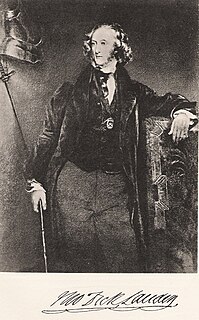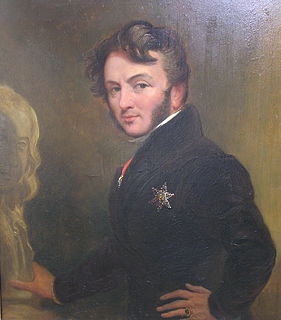
Robert Fergusson was a Scottish poet. After formal education at the University of St Andrews, Fergusson led a bohemian life in Edinburgh, the city of his birth, then at the height of intellectual and cultural ferment as part of the Scottish enlightenment. Many of his extant poems were printed from 1771 onwards in Walter Ruddiman's Weekly Magazine, and a collected works was first published early in 1773. Despite a short life, his career was highly influential, especially through its impact on Robert Burns. He wrote both Scottish English and the Scots language, and it is his vivid and masterly writing in the latter leid for which he is principally acclaimed.

David Roberts was a Scottish painter. He is especially known for The Holy Land, Syria, Idumea, Arabia, Egypt, and Nubia, a prolific series of detailed lithograph prints of Egypt and the Near East that he produced from sketches he made during long tours of the region (1838–40). These and his large oil paintings of similar subjects made him a prominent Orientalist painter. He was elected as a Royal Academician in 1841.

Sir Thomas Dick Lauder of Fountainhall, 7th Baronet, FRSE FSA(Scot) LLD was a Scottish author. He served as Secretary to the Board of Manufactures (1839–), on the Herring Fisheries Board, at the Royal Institution for the Encouragement of the Fine Arts, and as Deputy Lieutenant of both counties of Moray and Haddington.

Sir George Hayter was a notable English painter, specialising in portraits and large works involving in some cases several hundred individual portraits. Queen Victoria appreciated his merits and appointed Hayter her Principal Painter in Ordinary and also awarded him a Knighthood 1841.

Patrick Fraser Tytler FRSE FSA(Scot) was a Scottish advocate and historian. He was described as the "Episcopalian historian of a Presbyterian country".

Robert le diable is an opera in five acts composed by Giacomo Meyerbeer between 1827 and 1831, to a libretto written by Eugène Scribe and Germain Delavigne. Robert le diable is regarded as one of the first grand operas at the Paris Opéra. It has only a superficial connection to the medieval legend of Robert the Devil.

William Miller was a Scottish Quaker line engraver and watercolourist from Edinburgh.

John Lee FRSE was a Scottish academic and polymath, the Principal of the University of Edinburgh from 1840 to 1859. He was also a Moderator of the General Assembly of the Church of Scotland in 1844.
Marietta Sacchi was an Italian operatic soprano who had an active career during the 1820s and 1830s.
Sir Charles Dalrymple Fergusson, 5th Baronet of Kilkerran FRSE (1800–1849) was a Scottish lawyer.

Constance Jawureck (1803–1858) was a French mezzo-soprano opera singer.
Robert Edmonstone RSA (1794–1834), was a Scottish artist.
William Home Lizars was a Scottish painter and engraver.

Patric Park was a Scottish sculptor.
Critical and Miscellaneous Essays (1838-1839) is the title of a collection of reprinted reviews and other magazine pieces by the Scottish philosopher and historian Thomas Carlyle. Along with Sartor Resartus and The French Revolution it was one of the books that made his name. Its subject matter ranges from literary criticism to biography, history and social commentary. These essays have been described as "Intriguing in their own right as specimens of graphic and original nonfiction prose…indispensable for understanding the development of Carlyle's mind and literary career", and the scholar Angus Ross has noted that the review-form displays in the highest degree Carlyle's "discursiveness, allusiveness, argumentativeness, and his sense of playing the prophet's part."
Andrew Somerville RSA (1808–1834) was a short-lived Scottish artist. He is particularly noted for his illustration of Border ballads and several portraits.

Rebecca Isaacs was an operatic soprano of the mid-19th century who was the Directress of Operas at the Strand Theatre and who created the role of Leila in Satanella at the Royal Opera House in 1858.

William John Thomson (1771–1845) was an American-born painter of silhouettes, portraits and miniatures who was active in Great Britain.
A Queer Book (1832) is a collections of 26 poems, mostly short narratives, by James Hogg, all but two of which had been previously published, more than half of them in Blackwood's Edinburgh Magazine.
George Frederick Stansbury was a British composer, musical director and arranger and an operatic singer. Although contemporary reviewers described his voice as of "poor quality", he was nevertheless an excellent musician and a ready composer.












